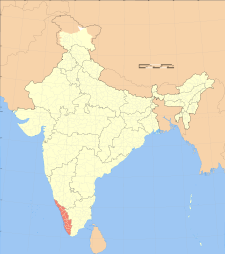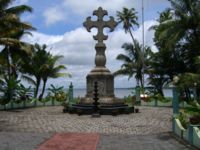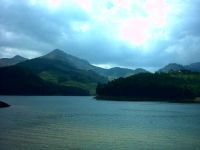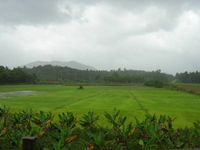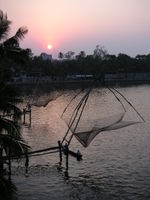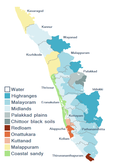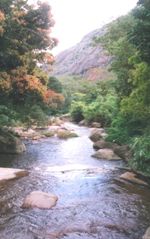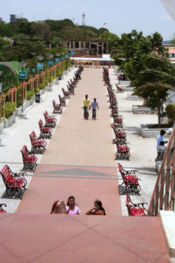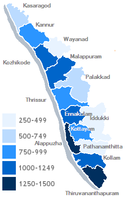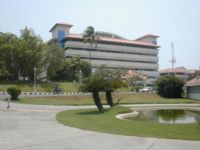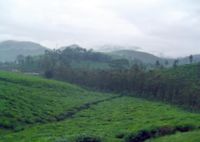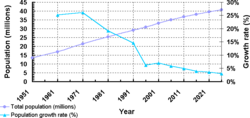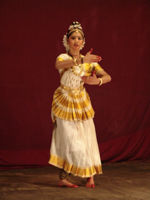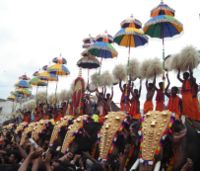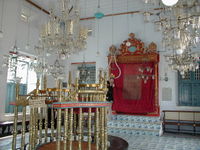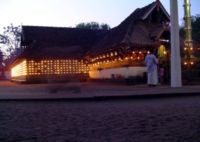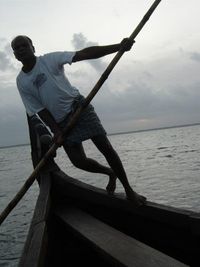Kerala
2007 Schools Wikipedia Selection. Related subjects: Geography of Asia
| Kerala | |
| Capital - Coordinates |
Thiruvananthapuram - |
| Largest city | Thiruvananthapuram |
| Largest metro | Kochi UA |
| Population (2001) - Density |
31,838,619 ( 12th) - 819/km² |
| Area - Districts |
38,863 km² ( 21st) - 14 |
| Time zone | IST ( UTC+5:30) |
| Establishment - Governor - Chief Minister - Legislature (seats) |
November 1, 1956 - R. L. Bhatia - V.S. Achuthanandan - Unicameral (141) |
| Official language(s) | Malayalam |
| Abbreviation (ISO) | IN-KL |
| Website: www.kerala.gov.in | |
|
Seal of Kerala |
|
Kerala ( ['keːɹəˌɭɐ] ; — Kēraḷaṁ) is a state on the Malabar Coast of southwestern India. To its east and northeast, Kerala borders Tamil Nadu and Karnataka; to its west and south lie the Indian Ocean islands of Lakshadweep and the Maldives, respectively. Kerala envelops Mahé, a coastal exclave of Pondicherry. Kerala is one of four states that compose the linguistic-cultural region known as South India.
First settled in the 10th century BCE by speakers of Proto-South Dravidian, Kerala was influenced by the Mauryan Empire. Later, the Cheran kingdom and feudal Namboothiri Brahminical city-states became major powers in the region. Early contact with overseas lands culminated in struggles between colonial and native powers. Finally, the States Reorganisation Act of November 1, 1956 elevated Kerala to statehood. Social reforms enacted in the late 19th century by Cochin and Travancore were expanded upon by post-Independence governments, making Kerala among the Third World's longest-lived, healthiest, most gender-equitable, and most literate regions. However, Kerala's rates of suicide, unemployment, and violent crime rank among India's highest.
The etymology of Kerala is disputed. The prevailing theory states that it is an imperfect portmanteau that fuses kera ('coconut palm tree') and alam ('land' or 'location'). Natives of Kerala — Keralites — thus refer to their land as Keralam. Other theories have the name originating from the phrase chera alam (Land of the Chera). Kerala's tourist industry, among others, also use the phrase God's own country.
History
According to legend, Parasurama (an avatar of Vishnu) caused the oceans to retreat, revealing Kerala. During Neolithic times, humans largely avoided Kerala's malarial rainforests and wetlands; thus, the first evidence of habitation — potsherds and dolmens — dates to the 10th century BCE. These were produced by speakers of a proto-Tamil language from northwestern India, suggesting that ancient Kerala and Tamil Nadu (part of Tamilakam) once shared a common language, ethnicity, and culture. By the early 14th century, Kerala had become a linguistically distinct region. The first major recorded kingdom, the Chera, ruled Kerala from Vanchi. Allied with the Pallavas, they warred against the Chola and Pandya kingdoms. A Keralite identity — distinct from the Tamils and associated with the second Chera empire and the development of Malayalam — evolved during the 8th–14th centuries. In written records, Kerala was first mentioned in the Sanskrit epic Aitareya Aranyaka. Later, figures such as Katyayana, Patanjali, Pliny the Elder, and the unknown author of the Periplus of the Erythraean Sea displayed familiarity with Kerala.
The Chera kings' dependence on trade meant that merchants from West Asia established coastal posts and settlements in Kerala. Many — especially Jews and Christians — also escaped persecution, establishing the Nasrani Mappila and Muslim Mappila communities. According to several scholars, the Jews first arrived in Kerala in 573 BCE. The works of scholars and Eastern Christian writings states that Thomas the Apostle visited Muziris in Kerala in 52 CE to proselytize amongst Kerala's Jewish settlements. However, the first verifiable migration of Jewish-Nasrani families to Kerala is of the arrival of Knai Thoma in 345 CE. Muslim merchants settled in Kerala by the 8th century CE. After Vasco Da Gama's arrival in 1498, the Portuguese sought to control the lucrative pepper trade by subduing Keralite communities and commerce.
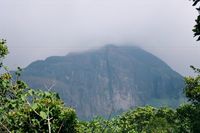
Conflicts between the cities of Kozhikode (Calicut) and Kochi (Cochin) allowed the Dutch to oust the Portuguese. In turn, the Dutch were ousted at the 1741 Battle of Colachel by Marthanda Varma of Travancore (Thiruvathaamkoor). Meanwhile, Mysore’s Hyder Ali conquered northern Kerala, capturing Kozhikode in 1766. In the late 18th century, Tipu Sultan — Ali’s son and successor — launched campaigns against the expanding British East India Company; these resulted in two of the four Anglo-Mysore Wars. He ultimately ceded Malabar District and South Kanara to the Company in the 1790s. The Company then forged tributary alliances with Kochi (1791) and Travancore (1795). Meanwhile, Malabar and South Kanara became part of the Madras Presidency.
Kerala saw comparatively little defiance of the British Raj — nevertheless, several rebellions occurred, including the October 1946 Punnapra-Vayalar revolt. Many actions — spurred by such leaders as Narayana Guru and Chattampi Swamikal — instead protested such conditions as untouchability; notable was the 1924 Vaikom Satyagraham. In 1936, Chitra Thirunal Bala Rama Varma of Travancore issued the Temple Entry Proclamation that opened Hindu temples to all castes; Cochin and Malabar soon did likewise.
After India's independence in 1947, Travancore and Cochin were merged to form Travancore-Cochin on July 1, 1949. On January 1, 1950 ( Republic Day), Travancore-Cochin was recognised as a state. Meanwhile, the Madras Presidency became Madras State in 1947. Finally, the Government of India's November 1, 1956 States Reorganisation Act inaugurated a new state — Kerala — incorporating Malabar District, Travancore-Cochin (excluding 4 southern Taluks which was merged with Tamil Nadu), and the taluk of Kasargod, South Kanara. A new Legislative Assembly was also created, for which elections were held in 1957. These resulted in a communist-led government — one of the world's earliest — headed by E.M.S. Namboodiripad. Subsequent social reforms introduced by Namboodiripad's administration — and continued by subsequent governments — favoured tenants and labourers. This facilitated, among other things, improvements in living standards, education, and life expectancies.
Geography
Kerala’s 38, 863 km² landmass (1.18% of India) is wedged between the Arabian Sea to the west and the Western Ghats — identified as one of the world's twenty-five biodiversity hotspots — to the east. Lying between north latitudes 8°18' and 12°48' and east longitudes 74°52' and 72°22', Kerala is well within the humid equatorial tropics. Kerala’s coast runs for some 580 km, while the state itself varies between 35–120 km in width. Geographically, Kerala can be divided into three climatically distinct regions: the eastern highlands (rugged and cool mountainous terrain), the central midlands (rolling hills), and the western lowlands (coastal plains). Located at the extreme southern tip of the Indian subcontinent, Kerala lies near the centre of the Indian tectonic plate; as such, most of the state (notwithstanding isolated regions) is subject to comparatively little seismic and volcanic activity. Geologically, pre-Cambrian and Pleistocene formations compose the bulk of Kerala’s terrain.
Eastern Kerala lies immediately west of the Western Ghats's rain shadow; it consists of high mountains, gorges and deep-cut valleys. Forty-one of Kerala’s west-flowing rivers — and three of its east-flowing ones — originate in this region. Here, the Western Ghats form a wall of mountains interrupted only near Palakkad, where a pass known as the Palakkad Gap breaks through to provide access to the rest of India. The Western Ghats rises on average to 1,500 m above sea level, while the highest peaks may reach to 2,500 m. Just west of the mountains lie the midland plains composing central Kerala; rolling hills and valleys dominate. Generally ranging between elevations of 250–1,000 m, the eastern portions of the Nilgiri and Palni Hills include such formations as Agastyamalai and Anamalai.
Kerala’s western coastal belt is relatively flat, and is criss-crossed by a network of interconnected brackish canals, lakes, estuaries, and rivers known as the Kerala Backwaters. Lake Vembanad — Kerala’s largest body of water — dominates the Backwaters; it lies between Alappuzha and Kochi and is more than 200 km² in area. Around 8% of India's waterways (measured by length) are found in Kerala. The most important of Kerala’s forty-four rivers include the Periyar (244 km), the Bharathapuzha (209 km), the Pamba (176 km), the Chaliyar (169 km), the Kadalundipuzha (130 km) and the Achankovil (128 km). Most of the remainder are small and entirely fed by monsoon rains. These conditions result in the nearly year-round water logging of such western regions as Kuttanad, 500 km² of which lies below sea level. As Kerala's rivers are small and lack deltas, they are more prone to environmental factors. Kerala's rivers face many problems, including summer droughts, the building of large dams, sand mining, and pollution.
| Agroecology of Kerala | |
|
|
|
|
|
|
With 120–140 rainy days per year, Kerala has a wet and maritime tropical climate influenced by the seasonal heavy rains of the Southwest Summer Monsoon. In eastern Kerala, a drier tropical wet and dry climate prevails. Kerala's rainfall averages 3,107 mm annually; the all-India average is 1,197 mm. Some of Kerala's drier lowland regions average only 1,250 mm; the mountains of eastern Idukki district receive more than 5,000 mm of orographic precipitation, the highest in the state. Kerala's rains mostly result from monsoons; more anomalous factors resulted in the red rains of 2001. Kerala . In summers, most of Kerala is prone to gale-force winds, storm surges, cyclone-related torrential downpours, occasional droughts, and rises in sea level and storm activity resulting from global warming. Kerala’s maximum daily temperature averages 36.7 °C; the minimum is 19.8 °C. Mean annual temperatures range from 25.0–27.5 °C in the coastal lowlands to 20.0–22.5 °C in the highlands.
Flora and fauna
Kerala's notable biodiversity is concentrated in the east. Almost a fourth of India's plant species, some 10,000 plant species, are found in the state. Among the almost 4,000 flowering plant species (1,272 of which are endemic to Kerala and 159 threatened) are 900 species of highly-sought medicinal plants. Its 9,400 km² of forests include tropical wet evergreen and semi-evergreen forests (lower and middle elevations — 3,470 km²), tropical moist and dry deciduous forests (mid-elevations — 4,100 km² and 100 km², respectively), and montane subtropical and temperate (shola) forests (highest elevations — 100 km²). Altogether, 24% of Kerala is forested. Two of the world’s Ramsar Convention-listed wetlands — Lake Sasthamkotta and the Vembanad-Kol wetlands — are in Kerala, as well as 1455.4 km² of the vast Nilgiri Biosphere Reserve. Subjected to extensive clearing for cultivation in the 20th century, much of Kerala's forest cover is now protected from clearfelling. Kerala's fauna are notable for their diversity and high rates of endemism: 102 species of mammals (56 of which are endemic), 476 species of birds, 202 species of freshwater fishes, 169 species of reptiles (139 of them endemic), and 89 species of amphibians (86 endemic). These are threatened by extensive habitat destruction (including soil erosion, landslides, salinization, and resource extraction).
Eastern Kerala’s windward mountains shelter tropical moist forests and tropical dry forests, which are common in the Western Ghats. Here, sonokeling (binomial nomenclature: Dalbergia latifolia — Indian rosewood), anjili (Artocarpus hirsutus), mullumurikku ( Erythrina), and Cassia number among the more than 1,000 species of trees in Kerala. Other flora include bamboo, wild black pepper (Piper nigrum), wild cardamom, the calamus rattan palm (Calamus rotang — a type of climbing palm), and aromatic vetiver grass ( Vetiveria zizanioides). Living among them are such fauna as Asian Elephant (Elephas maximus), Bengal Tiger (Panthera tigris tigris), Leopard (Panthera pardus), Nilgiri Tahr (Nilgiritragus hylocrius), Common Palm Civet (Paradoxurus hermaphroditus), and Grizzled Giant Squirrel (Ratufa macroura). Reptiles include the king cobra, viper, python, and crocodile. Kerala's birds are legion — Peafowl, the Great Hornbill (Buceros bicornis), Indian Grey Hornbill, Indian Cormorant, and Jungle Myna are several emblematic species. In lakes, wetlands, and waterways, fish such as kadu ( stinging catfish — Heteropneustes fossilis) and choottachi (orange chromide — Etroplus maculatus; valued as an aquarium specimen) can be found.
Subdivisions
Kerala's fourteen districts are distributed among Kerala's three historical regions: Travancore (southern Kerala), Kochi (central Kerala), and Malabar (northern Kerala).Travancore consists of Idukki, Alappuzha (Alleppey), Kottayam, Pathanamthitta, Kollam (Quilon), and Thiruvananthapuram (Trivandrum). Kochi includes Thrissur (Trichur) and Ernakulam districts. Malabar includes (from north to south) Kasargod, Kannur (Cannanore), Wayanad (Wynad), Kozhikode (Calicut), Malappuram, and Palakkad (Palghat).
| Districts of Kerala | |
|
|
|
| Source: Government of Kerala 2001. | |
Mahe, a part of the Indian union territory of Pondicherry, is a coastal exclave surrounded by Kerala on all of its landward approaches. Thiruvananthapuram is the state capital and most populous city; Kochi (the most populous urban agglomeration) , Kozhikode, Palakkad, Kollam and Thrissur are the other major commercial centres of the state. The High Court of Kerala is situated at Ernakulam. Kerala's districts, which serve as the administrative regions used for taxation purposes, are further subdivided into a total of 63 taluks; these have fiscal and administrative powers over settlements within their borders, including maintenance of local land records.
Politics
Like other Indian states and Commonwealth countries, Kerala is governed through a parliamentary system of representative democracy; universal suffrage is granted to residents. There are three branches of government. The legislature, or the legislative assembly, consists of elected members and special office bearers (the Speaker and Deputy Speaker) elected by assemblymen. Assembly meetings are presided over by the Speaker (or the Deputy Speaker if the Speaker is absent). The judiciary comprises the Kerala High Court (including a Chief Justice combined with 26 permanent and two additional (pro tempore) justices) and a system of lower courts. The executive authority — comprising the Governor of Kerala (the de jure head of state appointed by the President of India), the Chief Minister of Kerala (the de facto head of state: the Legislative Assembly's majority party leader is appointed to this position by the Governor), and the Council of Ministers (appointed by the Governor, with input from the Chief Minister). The Council of Ministers answers to the Legislative Assembly. Auxiliary authorities known as panchayats, for which local body elections are regularly held, govern local affairs.
Kerala hosts two major political alliances: the United Democratic Front (UDF — led by the Indian National Congress) and the Left Democratic Front (LDF — led by the CPI(M)). At present, LDF is the ruling coalition and V.S. Achuthanandan of the CPI(M) is the Chief Minister. Kerala is among India’s few left-wing states. Compared with most other Indians, Keralites are keener participants in the political process.
The Kerala state government's tax revenues (excluding the shares from Union tax pool) amounted to 111,248 million INR in 2005, up from 63,599 million in 2000. Its non-tax revenues (excluding the shares from Union tax pool) of the Government of Kerala as assessed by the Indian Finance Commissions reached 10,809 million INR in 2005, nearly double the 6,847 million INR revenues of 2000. However, Kerala's high ratio of taxation to gross state domestic product (GSDP) has not alleviated chronic budget deficits and unsustainable levels of government debt, impacting social services.
Economy
Since its incorporation as a state, Kerala's economy largely operated under welfare-based democratic socialist principles; nevertheless, the state is increasingly — along with the rest of India — liberalising its economy, thus moving to a more mixed economy with a greater role played by the free market and foreign direct investment. Kerala's nominal gross domestic product (as of 2004–2005) is an estimated 89451.99 crore INR, while recent GDP growth (9.2% in 2004–2005 and 7.4% in fiscal year 2003–2004) has been robust compared to historical averages (2.3% annually in the 1980s and between 5.1% and 5.99% in the 1990s). Nevertheless, relatively few major corporations and manufacturing plants choose to operate in Kerala; this is mitigated by remittances sent home by overseas Keralites, which contributes around 20% of state GDP. Kerala's per capita GDP — 11,819 INR — is significantly higher than the all-India average, although it still lies far below the world average. Additionally, Kerala's Human Development Index and standard of living statistics are the nation's best. This apparent paradox — high human development and low economic development — is often dubbed the " Kerala phenomenon" or the " Kerala model" of development, and arises mainly from Kerala's strong service sector.
The service sector (including tourism, public administration, banking and finance, transportation, and communications — 63.8% of statewide GDP in 2002–2003) along with the agricultural and fishing industries (together 17.2% of GDP) dominate Kerala's economy; nearly half of Kerala's people are dependent on agriculture alone for income. Some 600 varieties of rice (Kerala's most important staple food and cereal crop) are harvested from 310,521 ha (a decline from 588,340 ha in 1990) of paddy fields; 688,859 tonnes are produced per annum. Other key crops include coconut (899,198 ha), tea, coffee (23% of Indian production, or 57,000 tonnes), rubber, cashews, and spices — including pepper, cardamom, vanilla, cinnamon, and nutmeg. Around 10.50 lakh (1.050 million) fishermen haul an annual catch of 6.68 lakh (668,000) tonnes (1999–2000 estimate); 222 fishing villages are strung along the 590 km coast, while an additional 113 fishing villages are spread throughout the hinterland. Traditional industries manufacturing such items as coir, handlooms, and handicrafts employ around ten lakh (one million) people. Around 1.8 lakh (180,000) small-scale industries employ around 909,859 Keralites, while some 511 medium- and large-scale manufacturing firms are located in Kerala. Meanwhile, a small mining sector (0.3% of GDP) involves extraction of such materials as ilmenite (136,908.74 tonnes in 1999–2000), kaolin, bauxite, silica, quartz, rutile, zircon, and sillimanite. Home gardens and animal husbandry also provide work for hundreds of thousands of people. Other significant economic sectors are tourism, manufacturing, and business process outsourcing. Kerala's unemployment rate is variously estimated at 19.2% and 20.77%, although underemployment of those classified as "employed", low employability of many job-seeking youths, and a mere 13.5% female participation rate are significant problems. Estimates of the statewide poverty rate range from 12.71% to as high as 36%.
Transport
Kerala has 145,704 km of roads (4.2% of India's total). This translates into about 4.62 km of road per thousand population, compared to an all-India average of 2.59 km. Virtually all of Kerala's villages are connected by road. Traffic in Kerala has been growing at a rate of 10–11% every year, resulting in high traffic and pressure on the roads. Total road length in Kerala increased by 5% between 2003-2004. Kerala's road density is nearly four times the national average, reflecting the state's high population density. India's national highway network includes a Kerala-wide total of 1,524 km, which is 2.6% of the national total. There are eight designated national highways in the state. Upgrading and maintenance of 1,600 km of state highways and major district roads have been taken up by the Kerala State Transport Project (KSTP), which includes the GIS-based Road Information and Management Project (RIMS). Most of Kerala's west coast is accessible through two National Highways, NH 47 and NH 17.
Demographics
| Kerala's population (1951-2026) | |
|
|
|
| Sources: Tharakan & Navaneetham 1999, p. 36, Government of Kerala 2005b. | |
The 3.18 crore (31.8 million) of Kerala’s compound population is predominantly of Malayali Dravidian ethnicity, while the rest is mostly made up of Indo-Aryan, Jewish, and Arab elements in both culture and ancestry (both of which are usually mixed). Kerala is also home to 321,000 indigenous tribal Adivasis (1.10% of the populace), who are mostly concentrated in the eastern districts.. Malayalam is Kerala's official language; Tamil and various Adivasi languages are also spoken by ethnic minorities. Kerala is home to 3.44% of India's people, and — at 819 persons per km² — its land is three times as densely settled as the rest of India. However, Kerala's population growth rate is India's lowest; Indeed, Kerala's decadal growth (9.42% in 2001) is less than half the all-India average of 21.34%. Additionally, whereas Kerala's population more than doubled between 1951 and 1991 — adding 156 lakh (15.6 million) people to reach a total of 291 lakh (29.1 million) residents in 1991 — the population stood at less than 320 lakh (32 million) by 2001. Kerala's people are most densely settled in the coastal region, leaving the eastern hills and mountains comparatively sparsely populated.
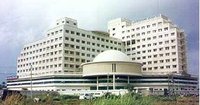
Women comprise 51.42% of the population, while Kerala's principal religions are Hinduism (56.1%), Islam (24.7%), and Christianity (19%). Remnants of a once substantial Cochin Jewish population — most of which made aliyah to Israel — also practice Judaism. In comparison with the rest of India, Kerala experiences relatively little sectarianism. Nevertheless, there have been signs of increasing influences from religious extremist organisations. In addition, Kerala has among the highest rates of criminality — including rates of rape and violent crime far above national averages — in India, ranking third among Indian states.
Kerala's society is less patriarchical than the rest of the Third World. Many Keralites (some Hindus, and the Muslims of Malabar) follow a traditional matrilineal system known as marumakkathayam. However, Christians, Muslims, and some Hindu castes such as the Namboothiri and Ezhava follow makkathayam, a patrilineal system. Kerala's gender relations are among the most equitable in India and the Third World. However, this too is coming under threat, from such forces as patriarchy-enforced oppression of women (for example, 45% of Keralite women have experienced at least one incident of physical violence, while domestic violence against women is on the rise), globalisation, modernisation, and " Sanskritisation" (the subaltern poor's emulation of higher castes).
Kerala's human development indices — elimination of poverty, primary-level education, and healthcare — are among the best in India. For example, Kerala's literacy rate (91%) and life expectancy (73 years) are now the highest in India. Meanwhile, Kerala's rural poverty rate fell from 69% (1970–1971) to 19% (1993–1994), while the overall (urban and rural) rate fell 36% during the 1970s and 1980s. These changes stem largely from efforts begun in the late 19th century by the kingdoms of Cochin and Travancore to boost social welfare. This focus was maintained by Kerala's post-independence government. However, Kerala's unemployment and suicide rates are high by Indian standards. Kerala's above-unity female-to-male ratio — 1.058 — also distinguishes it from the rest of India. The same is true of its sub-replacement fertility level and infant mortality rate (estimated at 12 to 14 deaths per 1,000 live births). However, Kerala's morbidity rate is higher than that of any other Indian state — 118 (rural Keralites) and 88 (urban) per 1,000 people; the corresponding all-India figures are 55 and 54 per 1,000, respectively. Kerala's 13.3% prevalence of low birth weight is substantially higher than that of First World nations. Further, outbreaks of water-borne diseases — including diarrhoea, dysentery, hepatitis, and typhoid — among the more than 50% of Keralites who rely on some 30 lakh (3 million) water wells constitutes another problem, a situation only exacerbated by the widespread lack of sewerage.
Kerala's healthcare system has garnered international acclaim, with UNICEF and the World Health Organization (WHO) designating Kerala the world's first "baby-friendly state" — for example, more than 95% of Keralite births are hospital-delivered. Aside from ayurveda (both elite and popular forms), siddha, and unani, many endangered and endemic modes of traditional medicine — including kalari, marmachikitsa, and vishavaidyam — are practiced. These propagate via gurukula discipleship, and comprise a fusion of both medicinal and supernatural treatments, and are partly responsible for drawing increasing numbers of medical tourists. A steadily aging population — 11.2% of Keralites are over age 60 — and low birthrate (18 per 1,000 — among the under-developed world's lowest) make Kerala (together with Cuba) one of the few regions of the Third World to have undergone the " demographic transition" characteristic of such developed nations as Canada, Japan, and Norway.
Culture & arts
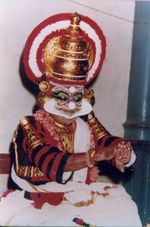
Kerala's culture is mainly Dravidian in origin, deriving from a greater Tamil-heritage region known as Tamilakam. Later, Kerala's culture was elaborated upon through centuries of contact with neighboring and overseas cultures. Native performing arts include koodiyattom, kathakali – from katha ("story") and kali ("performance") – and its offshoot Kerala natanam, koothu (akin to stand-up comedy), mohiniaattam ("dance of the enchantress"), thullal, padayani, and theyyam. Other arts are more religion- and tribal-themed. These include chavittu nadakom, oppana (originally from Malabar), which combines dance, rhythmic hand clapping, and ishal vocalisations. However, many of these artforms largely play to tourists or at youth festivals, and are not as popular among most ordinary Keralites. These people look to more contemporary art and performance styles, including those employing mimicry and parody. Additionally, a substantial Malayalam film industry effectively competes against both Bollywood and Hollywood.
Malayalam literature is ancient in origin, and includes such figures as the 14th-century Niranam poets (Madhava Panikkar, Sankara Panikkar and Rama Panikkar), whose works mark the dawn of both modern Malayalam language and indigenous Keralite poetry. The " triumvirate of poets" (Kavithrayam: Kumaran Asan, Vallathol Narayana Menon, and Ulloor S. Parameswara Iyer) are recognised for moving Keralite poetry away from archaic sophistry and metaphysics, and towards a more lyrical mode. In the second half of the 20th century, Jnanpith awardees like G Sankara Kurup, S. K. Pottakkat, and M. T. Vasudevan Nair have added to Malayalam literature. Later, such Keralite writers as O. V. Vijayan, M. Mukundan, and Booker Prize winner Arundhati Roy — whose 1996 semi- autobiographical bestseller The God of Small Things is set in the Kottayam town of Ayemenem — have gained international recognition.
Kerala's music also has ancient roots. Carnatic music dominates Keralite traditional music; this was the result of Swathi Thirunal Rama Varma's popularisation of the genre in the 19th century. Raga-based renditions known as sopanam accompany kathakali performances. Melam (including the paandi and panchari variants) is a more percussive style of music; it is performed at Kshetram-centered festivals using the chenda. Melam ensembles comprise up to 150 musicians, and performances may last up to four hours. Panchavadyam is a different form of percussion ensemble, in which up to 100 artists use five types of percussion instrument. Kerala has various styles of folk and tribal music. The popular music of Kerala — as in the rest of India — is dominated by the filmi music of Indian cinema. Kerala's visual arts range from traditional murals to the works of Raja Ravi Varma, the state's most renowned painter.
Kerala has its own Malayalam calendar, which is used to plan agricultural and religious activities. Kerala's cuisine is typically served as a sadhya on green banana leaves; such dishes as idli, payasam, pulisherry, puttucuddla, puzhukku, rasam, and sambar are typical. Keralites — both men and women alike — traditionally don flowing and unstitched garments. These include the mundu, a loose piece of cloth wrapped around men's waists. Women typically wear the sari, a long and elaborately wrapped banner of cloth, wearable in various styles.
Several ancient ritualised arts are Keralite in origin; these include kalaripayattu ( kalari ("place", "threshing floor", or "battlefield") and payattu ("exercise" or "practice")). Among the world's oldest martial arts, oral tradition attributes kalaripayattu's emergence to Parasurama. Other ritual arts include theyyam and poorakkali. However, Keralites are increasingly turning to more modern activities like cricket, kabaddi, soccer, and badminton. Dozens of large stadiums — including Kochi's Jawaharlal Nehru Stadium and Thiruvananthapuram's Chandrashekaran Nair Stadium — attest to the mass appeal of such sports among Keralites. Television (especially "mega serials" and cartoons) and the Internet have impacted Keralite culture. Yet Keralites maintain high rates of newspaper & magazine subscriptions— 50% — spend an average of about seven hours a week reading novels and other books, host a sizeable "people's science" movement, and participate in such activities as writers' cooperatives.
